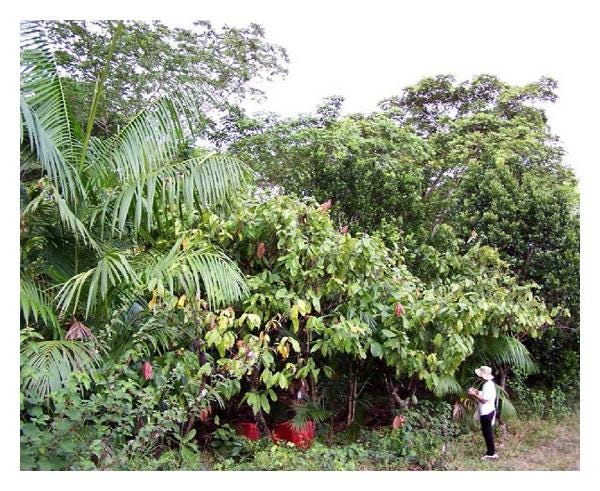Sri Lankan Tree Farms Help Native Birds
Plus Politics, Greenhouse Gasses From Our Food Production, and Hummingbirds
Tree Farms Help Sri Lankan Birds
Amid the thickets of the forests of Sri Lanka, red-backed flamebacks flit their way up and down tree trunks. Bright red wings cover the woodpeckers like capes, while streaks of white and black reach up their necks to their Jurassic heads and large beaks.
Sri Lankan wood pigeons distinguish themselves with their dusky emerald wings and white crowns. Green-billed coucals occupy dense foliage, stalking insects and small vertebrates. Brilliant red-faced malkoas are followed everywhere by their long, white-tipped tails.
These are just a handful of the beautiful birds found only in Sri Lanka. And the birds are just part of the larger unique ecosystems found on the island. Sri Lanka is small, about the size of West Virginia, yet its varied terrain and climate, as well as the island’s isolation from the mainland, has led to this portion of South Asia becoming a hotspot of biodiversity.
Within the island, there are dramatic differences in topography and climate. The Central Highlands are known for their breathtaking terrain, home to sweeping valleys, vertiginous cliffs, and peaks that exceed 7000 feet. Pidurutalagala, Sri Lanka’s highest peak, towers at almost 8300 feet.
The highlands catch the rains that come off the Indian Ocean, with some parts of the mountains drenched by more than 150 inches of rain in a year. In the north, rainfall averages range from 30 to 70 inches annually, which are usually received during the monsoon season, from May through October. Many areas in the north experience annual droughts that can last for more than three months.
Since the 1930s, however, Sri Lanka has suffered environmentally, losing about 30 percent of its forest cover, a plight similar to much of South Asia. The destruction has taken its toll on the native birds. Of the 33 endemic or possibly endemic birds, 17 are listed as vulnerable, near threatened, or endangered.
A team of researchers from Yale University and the University of Sri Jayewardenapura in Sri Lanka looked into how a particular type of farming might help Sri Lanka’s birds.
The researchers looked at tree gardens, a traditional way of farming throughout southern Asia, and whether the gardens can be places for the birds to live and find food. These gardens, or as people with degrees call them, multistrata agroforests, use the natural design of a forest, with an overstory and understory, as an environment to grow food and other agricultural items. Crops are planted around trees, and the trees themselves may be part of the harvestable system, with coconut and other fruit-bearing trees being integrated into a garden. Often intermediate stories of shrubs are added as well.
Besides Sri Lanka, tree gardens are used throughout India, Indonesia, Vietnam, Thailand, and Malaysia, and the practice has also been adopted in Brazil. In Sri Lanka, tree gardens are everywhere, making up almost half of the forested areas and 14 percent of the island’s total land area. Though folks have farmed tree gardens for centuries, there is ongoing research into the farming practices.

The scientists looked at bird populations around Pitakele, a village of around 30 households that borders the Sinharaja rainforest. Designated as a Sri Lankan National Park, a UNESCO Man and the Biosphere Reserve, UNESCO World Heritage Site, and a Bird Life International Important Bird Area, the Sinharaja rainforest occupies about 35 square miles at the southern tip of Sri Lanka and is one of the only remaining stands of connected, relatively undisturbed lowland rainforest on the island.
In an effort to maintain the wildlife of the reserve, the Sri Lankan government has set up a buffer zone, consisting of reforested areas as well as small villages, like Pitakele, that are meant to have a harmonious existence with the forest. Residents harvest tea from relatively small plots and rely on agriculture from tree gardens.
The researchers surveyed the birds in tea plots, tree gardens, and forest fragments. They wound up sighting 1269 individual birds, of 76 different species. They found 59 species in tree gardens, 48 in forest fragments, and 44 in the tea plots. The surveys showed that more birds, and more bird species, used tree gardens than forest fragments or tea plots in the study area. Tree gardens also had more endemic birds and birds of conservation concern. The team published its findings in Frontiers in Ecology and Evolution in February.
New Voices
I am hoping to feature some of the best new thinkers in the environmental movement with this newsletter. This week’s op-ed is by environmental activist Danielle Platt.
It’s time to Work, B*tch
I’ve always loved Brittany Spears; her iconic song “Work B*tch” will always be a classic, number 1 piece of musical genius in my book, followed only by Rhianna’s “Work,” which has a similar tempo, set of lyrics, and (as one might assume) set of thematic elements. Both are sung by gorgeous women singing about their careers as singers, entertainers, and cultural icons, living in the “man’s world” that is Hollywood’s sphere of musical fame.
I would really like a version of one of those pieces (or perhaps, better yet, a mashup of the two) sung by Biden-voting Democrats, possibly with a few lines of rap performed by our dear Vice President Kamala Harris. Why? Because I want our newly-elected leaders to remember their campaign promises and work diligently to fulfill them. And who knows? Maybe a musical accompaniment may sweeten the process for our newly electeds.
I recognize the notable hope that’s swept the country since November 7th’s announcement, and the promises of progress that have been made since January 20th’s inauguration, but hope and promises of a better future don’t exactly amount to policy change. And we need policy change, because unlike during the Obama years, Democrats (voters and representatives alike) do not have the luxury of sitting back, relaxing, and waiting for policy fixes to fall into place to reverse years of bad, corrupt, and quite frankly, deadly policy.
Quite frankly, also, Democrats shouldn’t have relaxed, and expected the Obama administration to fix years of bad policy resulting from 8 years of George Bush. Perhaps if public pressure had forced the Obama administration to act on their campaign promises of Hope, SocialEquity, Opportunity, and Responsibility, our government might have actually tightened regulations on big banks and their executives directly responsible for the 2009 housing market crash, or upheld antitrust and labor policies to prevent the monopolization and power-aggregation of huge corporations like AT&T, Anthem, and Amazon. And, maybe, just maybe, had these campaign promises really become policy, maybe we wouldn’t be seeing such depressed wages, nor the massive, growing disparity between rich and poor, nor the growing influence of corporate interests in political decision-making. Keep in mind that these are some of the key, unmitigated frustrations of American voters that got Trump elected. But I digress.
What many Democrats might not understand is that despite the campaign promises of our now-leaders, policy fixes do not simply “happen” because a representative introduces a policy. Campaign promises do not simply “happen” because a leader makes a promise to get new votes. Good policy happens when communities elect leaders who will listen to them (checkmark) and then consistently remind, pressure, lobby, and rally their leaders to pass the policy that they campaigned on (no checkmark here yet). Environmental protections were first passed in the 1960s and 1970s because communities choking on polluted air demanded better, and held their leaders accountable when they promised fixes and regulations to their constituents’ acute health needs. Labor protections were passed in a similar process of public need, public pressure, and public accountability; various legal protections for Black Americans, women, and other minority groups were won in the same way. Hell, even AOC, the sweetheart of the American Left, governs in the same way, and demands accountability from her fellow representatives in a fashion that is tangibly changing policy. What I’m trying to say is that campaign promises mean nothing without real change, and real change isn’t likely now without accountability from the tens of millions of Democrats who so passionately voted to remove Trump from office.
This new era of change that the Biden/Harris team has promised is essential to helping us “build back better” from the horror of the last four years. It’s now essential to ensure those campaign promises are kept, and it’s honestly concerning to see so many voters who put their hearts and souls into the 2020 race, now stepping back, assuming that those in power will do what they’ve promised. We need more than promises.
We (Democrats, liberals, moderates, and anyone pushing for progress) cannot fall into the complacency that characterized voter engagement (actually the lack thereof) during the Obama years.
Instead, we must keep the flame of our election passions burning bright, and hold the new administration to their promises.
Instead, we must demand a 15-dollar minimum wage and real labor protections. We must demand a Green New Deal, and improved access to medical care that doesn’t bankrupt us. We must demand regulations around data, and disinformation, and massive changes to end gerrymandering and voter suppression for good.
We need to demand policies that work for us, and not just for the 1%, or for the executives of massive corporations. Otherwise, we will have learned nothing, and in three and a half years, we may face another election with Trump, or someone even more dangerous, vying for the Oval Office.
So, we cannot be complacent. And we cannot let our leaders be complacent either.
And so, it’s time to ‘Work, B*itch’.
Danielle is a political organizer, advocate, educator, and community builder in Berkeley, California. As an activist with the Sunrise Movement, she worked on the ground in Arizona and Georgia to elect Joe Biden to the Office of the President, as well as Mark Kelly, Raphael Warnock, and Jon Ossoff to the U.S. Senate. A passionate advocate for real climate legislation and climate justice, she works to help communities tell their stories and demand change from their leaders. Check out her work at Hope.xyz.
Other News
Food Systems Account For Over One-Third of Global Greenhouse Gas Emissions According to UN Report
We’re all pretty familiar with the idea that turning the lights on, driving our cars, and flying airplanes release greenhouse gases and make the planet warmer. But growing, refrigerating, and transporting our food also warms the planet. A recent UN report says about one-third of the global warming gases we produce comes from our food systems.
The report says that our food production is growing more energy intensive because of changes in packaging, transportation, and food retail, although agriculture remains the largest food systems greenhouse gas producer.
The big driver of agricultural GHG is the methane that comes from livestock—mostly cows—and rice cultivation, which, combined, account for 35 percent of food systems GHG emissions.
The chlorofluorocarbons used in refrigeration warm the planet at a greater rate than CO2. This leads to their having a “turbocharged effect on global warming,” according to the authors of the report.
Nearly half the energy used in supermarkets and other food stores goes to refrigeration. Europe, which for decades eschewed the dependence on refrigeration that the U.S. developed, has become used to refrigerating its food and drink. The continent’s food sector emissions have quadrupled since 1990.
Pesticides Can Harm Hummingbirds
Pesticides are poison, so it makes sense that they can harm more than insects. Scientists exposed ruby-throated hummingbirds to varying concentrations of a neonicotinoid insecticide. It was found that exposure reduced the birds’ metabolism. The higher the concentration, the more the birds were affected. The findings were published in Nature in February.




